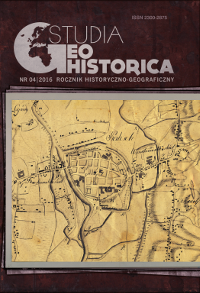Wpływy z czopowego jako wskaźnik lokalnego zróżnicowania poziomu produkcji piwa pełnego w miastach Królestwa Polskiego w latach 60. XVI w.
Income from Czopowe as an Indicator of Regional Diversity of Full Beer Production in the Cities of the Polish Crown in the 1560s
Author(s): Krzysztof BorodaSubject(s): Historical Geography, Maps / Cartography, Economic history, 16th Century
Published by: Polskie Towarzystwo Historyczne
Keywords: historia nowożytna;historia gospodarcza;geografia gospodarcza;GIS;browarnictwo;czopowe;piwo;modern history;economic history;economic geography;brewing industry;czopowe;beer
Summary/Abstract: The present article, on the basis of data on income from czopowe (liquor tax) attempts to assess local differences in the production of full beer in the cities of the Polish Crown in the 1560s. The source foundation of the study is made up from information from tax summaries on the amount of this tax paid by 486 cities in 1565 and 552 in 1569. The investigated material reveals a sharp discrepancy between the eastern and the western parts of the Kingdom, with the provisional border between the two constituted by the river Vistula in its middle course and the river San. Characteristic of the western part of the country was the existence of a dense network of small full-beer producing centres (paying either between 2000 and 5000 groszy of tax annually, or between 5000 and 10 000), located within distances of about 20–40 km from one another. This in turn suggests the existence of quite a tight network of local distribution centres across the rural areas, supplying the city-produced full beer, although the scale of rural consumption was rather modest. Those were complemented by much rarer middle-size production plants (10 000–20 000 and 20 000–50 000 groszy of tax annually). There are four regions in reference to which we may talk of the functioning of better receptive rural consumption markets of city-produced full beer – two of them were quite extensive, covering a large part of Royal Prussia in the north and the Cracow voivodeship in the south. The remaining two were, in contrast, territorially quite limited, spreading over only some patches of western Greater Poland (between Poznań and Wschowa), eastern Greater Poland and western Masovia (Piątek, Brzeziny, Łowicz). What is peculiar to the eastern part of the country is the lack of large and medium production plants and a much sparser location of small centres, the distances between which (usually exceeding 50 km) suggest the existence of only very modest and isolated local markets. The vast majority of urban centres located in this part of the country was characterised by an extremely low (not exceeding 2000 groszy annually) tax income, which seems to point to only minimal production of full beer.
Journal: Studia Geohistorica
- Issue Year: 2016
- Issue No: 4
- Page Range: 66-80
- Page Count: 15
- Language: Polish

